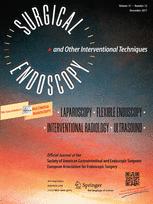Huang X, Chen S, Zhao H, Zeng X, Lian J, Tseng Y, Chen J
Surg Endosc. 2016 Aug 5. [Epub ahead of print].
BACKGROUND:
The efficacy of transoral incisionless fundoplication (TIF) performed with the EsophyX device (Redmond, Washington, USA) and its long-term outcomes in gastresophageal reflux disease (GERD) are debated. We, therefore, performed a systematic review with meta-analysis of studies evaluating the role of TIF in GERD.
METHODS:
A systematic search of EMBASE, SCOPUS, PubMed, and the Cochrane Library Central was performed. All original studies reporting outcomes in GERD patients who underwent TIF were identified. Only randomized controlled trials (RCTs) evaluating the efficacy of TIF, and prospective observational studies reporting outcomes after TIF were included.
RESULTS:
A total of 18 studies (963 patients) published between 2007 and 2015 were identified, including five RCTs and 13 prospective observational studies. The pooled relative risk of response rate to TIF versus PPIs/sham was 2.44 (95 % CI 1.25-4.79, p = 0.0009) in RCTs in the intention-to-treat analysis. The total number of refluxes was reduced after TIF compared with the PPIs/sham group. The esophageal acid exposure time and acid reflux episodes after TIF were not significantly improved. Proton-pump inhibitors (PPIs) usage increased with time and most of the patients resumed PPIs treatment at reduced dosage during the long-term follow-up. The total satisfaction rate after TIF was about 69.15 % in 6 months. The incidence of severe adverse events consisting of gastrointestinal perforation and bleeding was 2.4 %.
CONCLUSIONS:
TIF is an alternative intervention in controlling GERD-related symptoms with comparable short-term patient satisfaction. Long-term results showed decreased efficacy with time. Patients often resume PPIs at reduced doses in the near future.
Link to abstract on PubMed: Huang X, et al. Surg Endosc. 2016 Aug 5. [Epub ahead of print].


